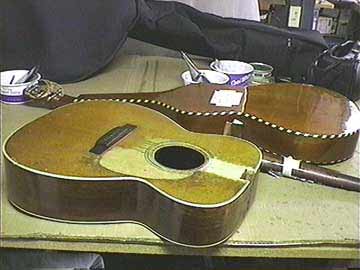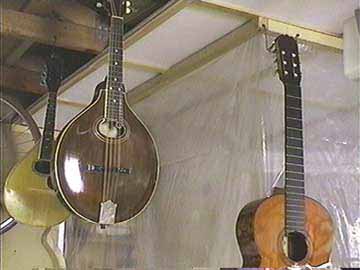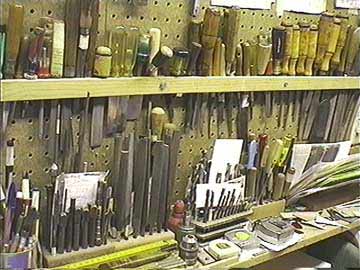FRETS.COM
Field Trip
Page 1 of 4
I pay a visit to Super Mario!
Mario Martello
© Frank Ford, 8/23/98; Photos by FF, 8/09/98
Update, 2006. Mario has passed away after
battling cancer for some months. Please
read his obituary written by Richard Johnston.

Here's my old friend, Mario. He's by far the most productive single instrument repair
person in Northern California. For most of the last 40 years, Mario has helped some
of the finest instrument shops build and maintain their reputations for elegant repair
work. During the important formative years of the 1960s and 1970s he did a majority
of the work for Jon Lundberg's shop in Berkeley, and Satterlee and Chapin Music in
San Francisco.
Whenever I see a repair job that's been sitting around my shop for too long, I
always ask myself, "What would Mario do?" That's usually all I need to
get the push to start the job. . .
Mario was born in Northern Italy, in 1924, and his family moved to Argentina
when he was very young.
His father had his own woodworking shop and built cabinets, architectural woodwork
and some furniture. Working at his father's side, Mario gained proficiency in the
traditional woodworking and finishing techniques.
"My father did mostly carpentry and fine woodwork for the inside of buildings."
At the age of 33, Mario moved to New York City with his wife and son. He landed a
job in a furniture factory, making and repairing reproduction period style furniture.
A friend suggested that he contact John D’Angelico to see about getting
a job making and repairing guitars, but D’Angelico said he didn’t need extra help
right then. After a year and a half Mario's father died and his wife wanted to return
to Argentina.
“But I didn’t stay long because I see the situation and I say, 'No I don’t want
to stay here.'"
A short while later, Mario came back by himself to the United States,
eventually deciding that San Francisco was the place for him.
“I didn’t like the weather in New York. It was too cold.”
By the time he sent for his wife and son to join him, her visa had expired and it
would be a year’s wait before she could reenter the U.S. In
1960, while Mario worked at sofa manufacturer in San Francisco, a coworker told him
he wanted to make a guitar. His friend went to Acoma music on Market Street, and
bought some guitar making supplies and wood. He told John Paul, the owner, that his
friend, Mario, was going to help him. John Paul said, “If your friend knows about
making guitars, why don’t you send him over. We need some help here.”
“John Paul had traveled a lot in Mexico, and spoke some Spanish, so I we could
talk together. He handed me over this big book with instructions about making violins
and cellos, and asked me if I understood these things. ‘I said, I'm sorry I don’t
know much about cellos, I do mostly guitars and things like that.’ He said he would
take me over to see Harmon Satterlee because he needed a helper in his store. He
took me there because that's where he took all his jobs - repairs on violins, basses,
guitars, everything. He don’t do repairs. Acoma was a real nice store. Got a lot
of business. Satterlee tried me a couple of Saturdays, and I got the job. I worked
on a lot of violins, guitars, harps, all kinds of instruments.”
He worked for Satterlee for seven years, doing all kinds of repairs on every sort
of stringed instrument.
John Lundberg brought repairs to Satterlee and Mario would do them there. He asked
Mario why he didn’t just work for himself and pick up repairs. Mario thought about
it and quit Satterlee, setting up his shop in his garage. “After all, most of the
time I worked for myself when I ran my father’s business, so it came natural. Since
the days I worked for Satterlee, I've always worked for myself.”
“I got so much experience working for Satterlee I could handle any kind of instrument.
With experience, you're not afraid to start a job. Once you get started and work
careful, then everything goes fine. You can't let the work sit around.”
Click here to see Mario's latest
guitar, the "San Franciscan"
Mario lives in a quiet neighborhood in Martinez, California. His two-car garage shop
is always neat and tidy. He keeps his power tools on casters so they can be stored
in the corner when not in use:

Notice the green painted floor. It's swept clean so he can find the smallest wood
chip or small part that might fall during a repair operation.
There's a simple table in the center to hold jobs in progress:

A couple of instruments hang outside the "clean corner" where he does his
French polishing and other finish work:

At the end of his workbench is the ever handy glue pot:

Mario uses the classic hide glue for most operations
Behind his workbench is a crowded board with all manner of hand tools:

Like many of us, Mario believes that repairing instruments is best done working by
hand. A large number of Mario's hand tools are ones he made or modified himself.
He describes his experiences working in his father's shop as essentially a nineteenth
century style of business.
"If you don't have the tool you need, you make one. If you don't have the
parts you need, you make them, too."
More
1
2
3
4
Back to Index Page